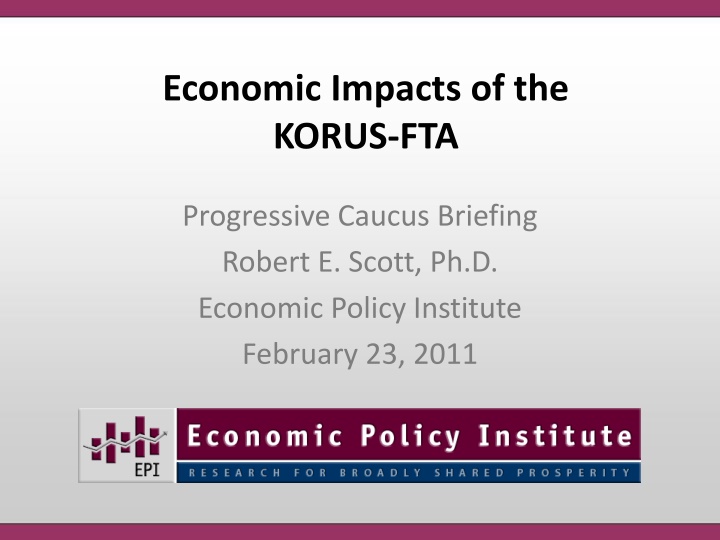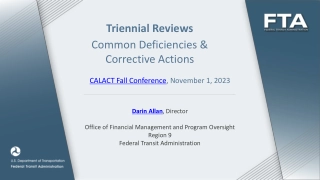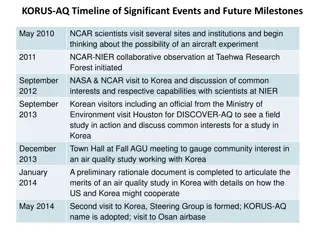
Economic Impacts of KORUS-FTA Briefing by Robert E. Scott, Ph.D.
Discover the projected impacts of KORUS-FTA through a detailed briefing by Robert E. Scott, Ph.D. Learn about trade balance, exports, imports, GDP, and job implications, as analyzed by the US International Trade Commission and Economic Policy Institute. Explore the differences between USITC projections and actual outcomes, as well as the likely impacts of trade agreements with Colombia and Korea, including insights on total US trade with Korea from 1997 to 2010.
Download Presentation

Please find below an Image/Link to download the presentation.
The content on the website is provided AS IS for your information and personal use only. It may not be sold, licensed, or shared on other websites without obtaining consent from the author. If you encounter any issues during the download, it is possible that the publisher has removed the file from their server.
You are allowed to download the files provided on this website for personal or commercial use, subject to the condition that they are used lawfully. All files are the property of their respective owners.
The content on the website is provided AS IS for your information and personal use only. It may not be sold, licensed, or shared on other websites without obtaining consent from the author.
E N D
Presentation Transcript
Economic Impacts of the KORUS-FTA Progressive Caucus Briefing Robert E. Scott, Ph.D. Economic Policy Institute February 23, 2011
Table 1 Projected Impacts of Trade Agreements (billions of dollars) Trade Balance Exports Imports GDP Jobs U.S. International Trade Commission (USITC) KORUS-max* Bilateral Global US Colombia 10.9 5.3 1.1 6.4 40.2 6.9 5.7 0.5 6.2 0.0 4.0 -0.4 0.6 0.2 40.2 11.9negligible 2.5minimal/none**** 14.4minimal 44.8 total-USITC** Chamber study*** 338,352 *The ITC KORUS study project a range of trade impacts: Exports $9.7-10.9 billion, and Imports $6.4-6.9 billion. **The ITC predicts that the US-Panama TPA would have a "small" impact on the U.S. economy; it did not estimate the impacts of this agreement on U.S. global trade flows (USITC 2007b). Total-USITC reflects sum of global trade impacts of the KORUS-max scenario and the US-Columbia trade estimates (no global impacts estimated in that study). ***Combined impacts of falure to enact US Korea, Colombia and Panama trade agreements, including the global impact of the KORUS agreement (only--bilateral U.S. Korea trade is not included) and the bilateral impact of the U.S.-ColumbiaTrade Promotion Agreement. ****U.S. output (quantity and revenue) of sugar were projected to decline by 0.3%, and employment of skilled and unskilled labor in this sector is also projected to decline by the 0.3%. Sources: USITC (2006, and 2007b) and Baughman and Francois (2009), Scott, Robert E. 2010. Trade policy and job loss; Washington, D.C.: Economic Policy Institute. Working paper #289, Febraruary 25. http://www.epi.org/publications/entry/trade_policy_and_job_loss/ ; Table updated to reflect global results in USITC March 2010, corrected printing. U.S. International Trade Commission. 2010. "U.S. Korea Free Trade Agreement: Potential Economy- wide and Selected Sectoral Effects." Washington, D.C.: U.S. International Trade Commission. Publication 3949. Corrected printing. March 2010. http://www.usitc.gov/publications/docs/pubs/2104F/pub3949.pdf
Likely impacts of trade agreements with Colombia and Korea
Trade agreements with Colombia and Korea: Jobs impact
Total U.S. trade with Korea, 1997 - 2010 60.0 Imports 47.9 50.0 46.7 45.4 45.1 44.7 43.2 39.8 38.8 40.0 36.9 36.8 35.3 34.9 33.1 33.0 Exports 31.2 30.8 30.0 27.1 26.3 26.2 25.0 24.3 22.9 23.7 22.5 22.0 billions of U.S. dollars 21.2 20.9 20.0 16.0 10.0 1.3 0.0 -10.0 -7.7 -9.1 -11.1 -11.7 -12.4 -13.5 -13.6 -13.9 -14.0 -14.1 -14.4 -16.9 -20.0 -20.1 Trade balance -30.0 1997 1998 1999 2000 2001 2002 2003 2004 2005 2006 2007 2008 2009 2010 Source: U.S. International Trade Commission and Economic Policy Institute
U.S. - Korea vehicle and parts trade, 1997 - 2010 15.0 11.3 11.1 11.1 10.7 10.1 10.0 10.0 Imports 8.8 8.0 7.6 7.0 5.4 5.0 Exports 3.4 2.2 billions of U.S. dollars 2.1 0.8 0.7 0.7 0.6 0.6 0.6 0.5 0.4 0.4 0.4 0.4 0.3 0.3 0.3 0.0 -1.6 -1.8 -3.0 -5.0 -5.0 -6.7 -7.3 -7.7 -8.5 -10.0 -9.3 -9.4 -10.2 -10.3 Trade balance -10.6 -10.7 -15.0 1997 1998 1999 2000 2001 2002 2003 2004 2005 2006 2007 2008 2009 2010 Source: U.S. International Trade Commission and Economic Policy Institute
Motor vehicle and parts share of U.S. - Korea trade balance, 1997 - 2010 100% 50% 0% share -50% -100% -150% 1997 1998 1999 2000 2001 2002 2003 2004 2005 2006 2007 2008 2009 2010 Source: U.S. International Trade Commission and Economic Policy Institute
Lessons from NAFTA 1. U.S. Mexico Trade was balanced in 1993, prior to the agreement 2. The U.S. has experience rapidly growing trade deficits and job displacement since NAFTA was implemented 3. Job losses are concentrated in motor vehicles and electronics 4. Oil is a big part of trade with Mexico, but has only minor impacts on employment.
U.S. Mexico trade before & after NAFTA, 1989 - 2010 250.0 NAFTA takes effect 1/1/94 200.0 Imports 150.0 100.0 Exports billions of dollars 50.0 0.0 Trade balance -50.0 -100.0 -150.0 1989 1990 1991 1992 1993 1994 1995 1996 1997 1998 1999 2000 2001 2002 2003 2004 2005 2006 2007 2008 2009 2010 Source: U.S. International Trade Commission and Economic Policy Institute.
U.S. Mexico trade and job displacement, 1997-2010 U.S. trade with Mexico ($billions, nominal) Changes in: ($billions) 2000-07 $18.9 75.4 -56.5 Percent change 1997-2010 1997 $68.4 85.0 -16.6 2000 $100.4 134.7 -34.3 2007 $119.4 210.2 -90.8 2010 $131.6 228.8 -97.2 1997-2000 $32.0 49.7 -17.7 2007-10 $12.2 18.7 -6.4 U.S. domestic exports* U.S. imports for consumption U.S. trade balance Average annual change in the trade balance 92% 169% 485% -5.9 -8.1 -2.1 15% U.S. trade-related jobs supported and displaced (thousands of jobs) Changes in: (thousands of jobs) 1997-2000 243.4 Percent change 1997-2010 51% 1997 523.7 2000 767.1 2007 780.7 2010 791.9 2000-07 13.6 2007-10 11.2 U.S. domestic exports U.S. imports for consumption- jobs displaced U.S. trade deficit-net jobs lost 626.3 102.6 966.7 199.6 1,347.2 566.5 1,474.8 682.9 340.4 97.0 380.5 366.9 127.6 116.4 135% 566% Average annual job displacement 32.3 52.4 38.8 10% Source: EPI analysis of Census Bureau, ITC, and BLS data Preliminary analysis: NOT FOR QUOTATION OR DISTRIBUTION
Change in net jobs created or displaced by industry, 2010 Industry total* 8,200 -21,000 -17,600 -3,300 -2,000 -11,100 -415,000 -22,200 5,700 -3,600 6,400 -3,400 -22,100 -5,200 3,200 -1,500 4,800 Share of total -1.2% 3.1% 2.6% 0.5% 0.3% 1.6% 60.8% 3.3% -0.8% 0.5% -0.9% 0.5% 3.2% 0.8% -0.5% 0.2% -0.7% Agriculture, forestry, fisheries Mining Oil and gas Minerals and ores Utilities Construction Manufacturing Non-durable goods Food and kindred products Beverage and tobacco products Textiles and fabrics Textile mill products Apparel and accessories Leather and allied products Industrial supplies Wood products Paper Printed matter and related products Petroleum and coal products Chemicals Plastics and rubber products Nonmetallic mineral products -2,500 1,700 13,100 -2,300 -10,000 0.4% -0.2% -1.9% 0.3% 1.5% Source: EPI analysis of Census Bureau, ITC, and BLS data Preliminary analysis: NOT FOR QUOTATION OR DISTRIBUTION
Change in net jobs created or displaced by industry, 2010 (Continued) Industry total* -396,000 -22,900 -39,200 0 -7,200 -150,300 Share of total 58.0% 3.4% 5.7% 0.0% 1.1% 22.0% Durable goods Primary metal Fabricated metal products Not specified metal industries Machinery, except electrical Computer and electronic parts Computer and peripheral equipment Communications, audio and video equipment Navigational, measuring, electromedical, and control instruments Semiconductor and other electronic components & magnetic and optical media production Electrical equipment, appliances, and component Transportation equipment Motor vehicles and parts Aerospace product and parts Railroad, ship, and other transportation equipment Furniture and fixtures Miscellaneous manufactured commodities -27,600 4.0% -82,800 12.1% -14,900 2.2% -24,900 3.6% -38,600 -105,500 -108,000 2,000 5.7% 15.4% 15.8% -0.3% 400 -9,600 -0.1% 1.4% -22,300 3.3% Source: EPI analysis of Census Bureau, ITC, and BLS data Preliminary analysis: NOT FOR QUOTATION OR DISTRIBUTION
Jobs lost through imports, jobs gained through exports, and net job change, due to trade with Mexico, 2010 Top 12 hardest hit states Total Share of total state employment in 2005-07 -0.96% -0.81% -0.65% -0.64% -0.59% -0.58% -0.57% -0.56% -0.53% -0.52% -0.52% -0.51% Import jobs Export jobs Net job change employment 4,552,700 3,000,700 1,863,500 5,412,100 2,778,500 694,200 6,087,800 1,995,900 3,241,300 10,602,400 16,565,000 2,849,100 Rank 1 2 3 4 5 6 7 8 9 10 11 12 Michigan Indiana Kentucky Ohio Tennessee New Hampshire Illinois Alabama Massachusetts Texas California Wisconsin -80,500 -49,500 -25,200 -75,100 -35,100 -8,200 -73,000 -24,500 -33,700 -113,100 -174,200 -37,200 36,800 25,000 13,000 40,200 18,600 4,100 38,300 13,300 16,600 57,500 87,700 22,700 -43,600 -24,400 -12,100 -34,900 -16,400 -4,000 -34,700 -11,100 -17,100 -55,600 -86,500 -14,500 Source: EPI analysis of Census Bureau, ITC, and BLS data Preliminary analysis: NOT FOR QUOTATION OR DISTRIBUTION
Links Snapshot: Free Trade Agreement with Korea will Cost U.S. Jobs. July 1, 2010. Working paper: Trade Policy and Job Loss. February 25, 2010. Research Assistance by Anna Turner.





















